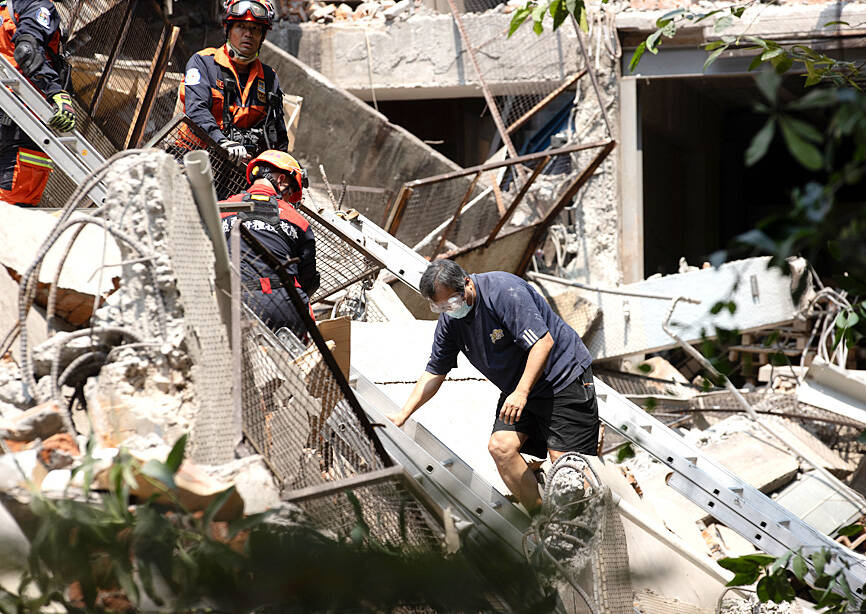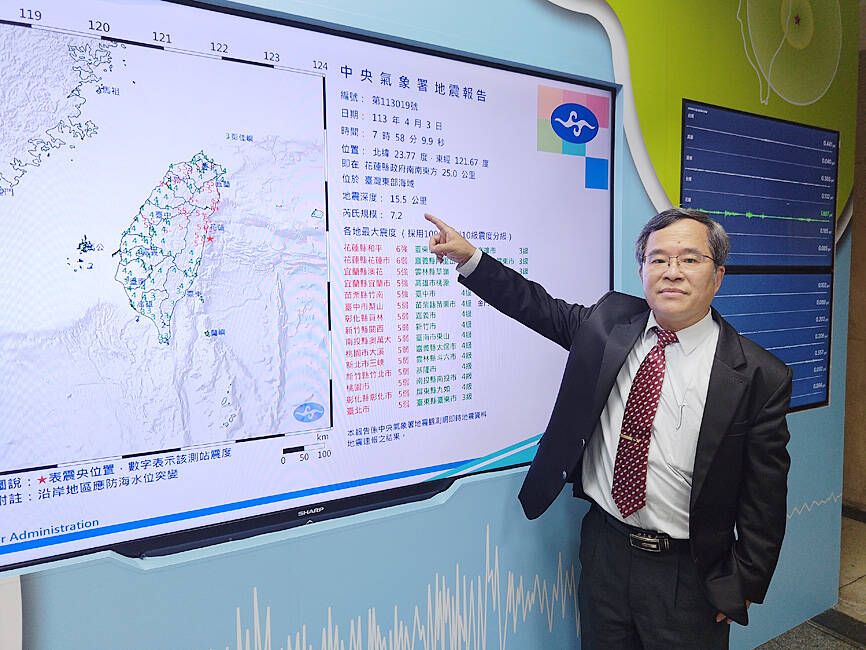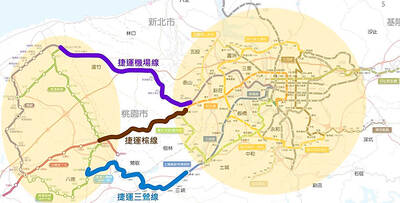People should prepare for a magnitude 8 or larger earthquake striking near the east coast after the nation was yesterday morning jolted by a magnitude 7.2 quake, a seismologist said.
Yesterday’s temblor, with the epicenter off Hualien County, was the largest since the nation was devastated by a magnitude 7.3 quake on Sept. 21, 1999, also known as the 921 Earthquake.
So far, yesterday’s earthquake and more than 100 aftershocks had led to multiple deaths and injuries, as well as housing and infrastructure damage. Hualien County reported the severest destruction due to its proximity to the epicenter.

Photo: Wang Yi-sung, Taipei Times
Ma Kuo-fong (馬國鳳), a research fellow of Academia Sinica’s Institute of Earth Sciences, said that yesterday’s quake was primarily caused by the seismic movement at the Ryukyu Trench, which is close to Hualien’s coast.
In 1920, a magnitude 8 earthquake occurred in the trench, Ma said, citing historical records, adding that as a magnitude 7 or greater temblor could strike off Hualien’s coast every 60 to 100 years, yesterday’s quake should not come as a surprise.
Such a large earthquake is also expected, as Taiwan is hit with a magnitude 7 or larger quake about every 30 years, and the nation is this year to observe the 25th anniversary of the 921 Earthquake, she said.

Photo: Wu Po-hsuan, Taipei Times
A stronger earthquake could potentially occur as the seismic energy continues to build up at the trench, she said.
As to why an earthquake originated in Hualien could generate such strong repercussions in Taipei, Ma said that the capital is a basin formed through accumulation of sediments, and the effects of seismic waves tend to be amplified when they are transmitted through unfavorable geological surface layers.
Moreover, people tend to be more keenly aware of earthquakes when they experience them in tall buildings such as those in Taipei, she said.
Ma attributed the relatively fewer disaster reports in Taipei to earthquake alerts being issued on smartphones and that more people in the past few years have an awareness of disaster prevention.
However, local governments need to speed up urban renewal projects to remove old and unsafe buildings, she said.
Buildings in elementary and middle schools should also be reinforced to be more earthquake-resistant, she said.
Yesterday’s temblor shook more parts of the nation with greater intensity than any other since 1999, when the 921 Earthquake toppled hundreds of buildings in central Taiwan, Central Weather Administration (CWA) Seismology Center Director Wu Chien-fu (吳健富) said.
Yesterday’s earthquake’s intensity, which gauges the actual effect of a seismic event, was highest in Hualien, where it measured 6+ on Taiwan’s 7-tier scale, the CWA said.
A 6+ intensity represents shaking that makes it almost impossible to stand in place and can even throw people into the air.
An intensity of 5+ was recorded in Yilan County, up the coast from Hualien County, and in Miaoli County, and 5- in Taipei, New Taipei City, Taoyuan, Taichung, and Hsinchu, Changhua and Nantou counties.
At those intensity levels, people might still find it hard to stand and loose items might topple over.
Yesterday was only the second time an intensity level of 6+ had occurred in Taiwan since the introduction of the new seismic intensity scale in 2020, Wu said.
Former CWA seismological center director Kuo Kai-wen (郭鎧紋) said that yesterday’s earthquake was different from the 921 Earthquake in that the seismic energy released through the latter was equivalent to the explosion of 46 atomic bombs.
The energy released through yesterday’s earthquake was equivalent to the explosion of 32 atomic bombs, Kuo said.
“The epicenter of the 921 Earthquake was at the Chelungpu Fault (車籠埔斷層) on land, which is about 100km long. It led to severe casualties and damage because it occurred at the nation’s densely populated west coast,” he said, adding that Hualien, the city closest to yesterday’s quake, has a smaller population.
A magnitude 6.2 earthquake can release energy equivalent to that of one atomic bomb, he said.
“Normally, Taiwan should release energy equivalent to that of eight atomic bombs to avoid the occurrence of large earthquakes,” he said.
In 2022, Taiwan recorded 12 magnitude 6 or larger earthquakes, which is a normal release of energy, he said, adding that the earthquake cycle was in a relatively peaceful phase last year.
Additional reporting by CNA

“China is preparing to invade Taiwan,” Deputy Minister of Foreign Affairs Francois Wu (吳志中) said in an exclusive interview with British media channel Sky News for a special report titled, “Is Taiwan ready for a Chinese invasion?” the Ministry of Foreign Affairs said today in a statement. The 25-minute-long special report by Helen Ann-Smith released yesterday saw Sky News travel to Penghu, Taoyuan and Taipei to discuss the possibility of a Chinese invasion and how Taiwan is preparing for an attack. The film observed emergency response drills, interviewed baseball fans at the Taipei Dome on their views of US President

The Central Weather Administration (CWA) today issued a "tsunami watch" alert after a magnitude 8.7 earthquake struck off the Kamchatka Peninsula in northeastern Russia earlier in the morning. The quake struck off the east coast of the Kamchatka Peninsula at 7:25am (Taiwan time) at a depth of about 19km, the CWA said, citing figures from the Pacific Tsunami Warning Center. The CWA's Seismological Center said preliminary assessments indicate that a tsunami could reach Taiwan's coastal areas by 1:18pm today. The CWA urged residents along the coast to stay alert and take necessary precautions as waves as high as 1m could hit the southeastern

ECONOMIC BENEFITS: The imports from Belize would replace those from Honduras, whose shrimp exports have dropped 67 percent since cutting ties in 2023 Maintaining ties with Taiwan has economic benefits, Ministry of Foreign Affairs officials said yesterday, citing the approval of frozen whiteleg shrimp imports from Belize by the Food and Drug Administration (FDA) as an example. The FDA on Wednesday approved the tariff-free imports from Belize after the whiteleg shrimp passed the Systematic Inspection of Imported Food, which would continue to boost mutual trade, the ministry said. Taiwan’s annual consumption of whiteleg shrimps stands at 30,000 tonnes, far exceeding domestic production, the ministry said. Taiwan used to fill the gap by importing shrimps from Honduras, but purchases slumped after Tegucigalpa severed diplomatic ties with Taiwan

The Executive Yuan yesterday approved a southwestern extension of the Sanying MRT Line from New Taipei to Bade District (八德) in Taoyuan, with a goal of starting construction by late 2026. The 4.03-kilometer extension, featuring three new stations, will run from the current terminus at Yingtao Fude Station (LB12) in New Taipei City to Dannan Station (LB14), where it will connect with Taoyuan’s Green Line, New Taipei City Metro Corp said in a statement. This extension will follow the completion of core Sanying Line, a 14.29-kilometer medium-capacity system linking Tucheng (土城), Sansia (三峽)